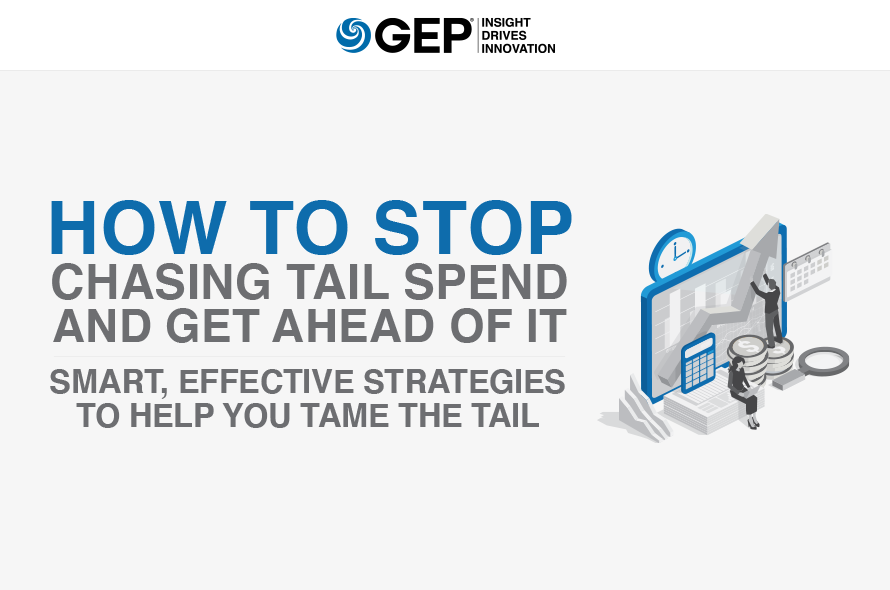Let’s admit. Managing tail spend has never been easy (or exciting). It’s messy, chaotic, resource-intensive — enough said. But it has to be done. And effectively.
The good news is, there are ways and means to tame tail spend.
A new GEP paper, How to Stop Chasing Tail Spend and Get Ahead of It, explores how a technology-driven approach can help your procurement team get ahead of tail spend. The paper also discusses specific areas of tail-spend automation that you should focus on and prioritize for success.
What’s Inside:
- Using the right technology to manage more spend, more effectively
- Specific areas of automation to help you cut costs and enhance efficiency
- Opportunities in direct tail spend management
It’s a must-read for procurement leaders seeking effective ways to reduce tail spend and create more value for the enterprise.
INTRODUCTION: NEW FRONTIERS FOR DIGITAL TRANSFORMATION
In the wake of the recent shocks to the global economic and business environment, leading procurement organizations have renewed their focus on managing tail spend as part of their overall cost control strategy. And there’s ample justification for this; when done correctly, tail spend management (TSM) can be a major source of incremental savings. However, with poor data visibility and persistent reliance on labor-intensive manual processes, organizations have found dealing with a vast number of transactions and a largely anonymous supply base very challenging.
The COVID-19 pandemic triggered health care and humanitarian crises that have led to deliberation at the organizational level. Companies have been pushed to accept the need to make substantial changes that will better equip them to manage through disruption. In the quest for improved agility, organizations are increasingly investing in automation and optimization strategies to accelerate speed to market and improve user experience.
The shift to automation is mainly driven by the increased availability of digital technologies and quantifiable benefits of these technologies in creating end-to-end supply chain visibility. For mature organizations, tail spend is one of the key focus areas for automation.
TAIL SPEND REDEFINED AND CLARIFIED
The definition of tail spend has changed over the years. As it’s understood today, the term speaks better to “invisible” suppliers and ad hoc purchases that are low-volume, low-frequency, or low-value.
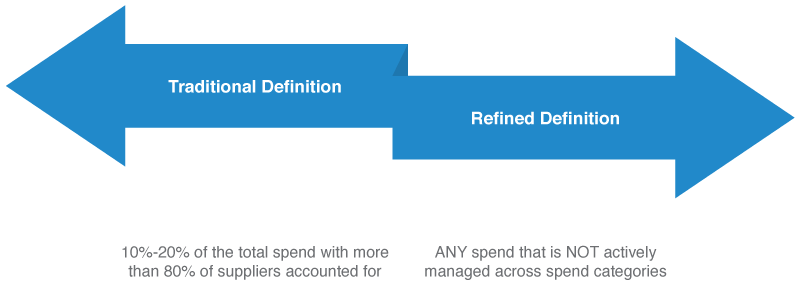
Effective TSM strategies and operating models require a quantitative understanding of spend. As illustrated below, an organization’s addressable spend is evaluated based on three criteria: business criticality, transaction value and transaction frequency.
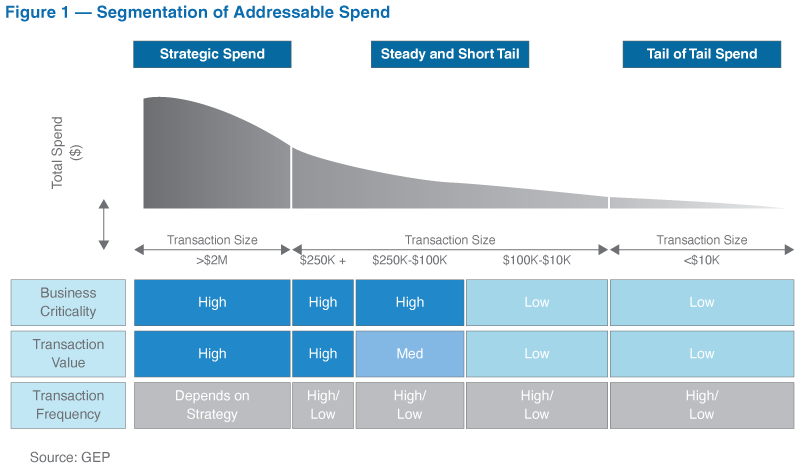
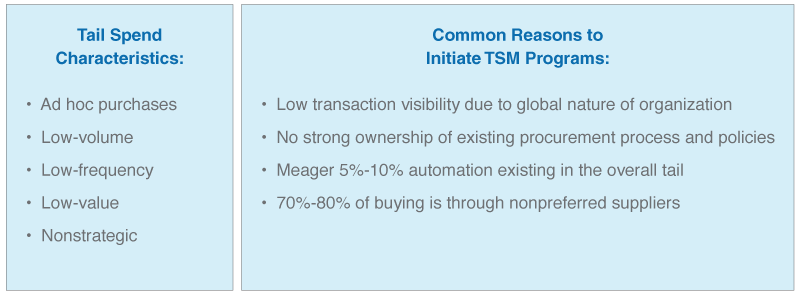
INCORPORATING DIGITAL TECHNOLOGY INTO TAIL SPEND MANAGEMENT
Digital technologies allow for more impactful TSM programs that can:
- Drive value via price reductions, supplier base consolidation and improved contractual terms
- Leverage cross-regional tail spend to consolidate the supply base
- Ensure that new strategic initiatives do not pose a risk to the business, or to customers
A source-to-pay (S2P) platform with artificial intelligence (AI) and machine learning capabilities is an effective foundation for a successful program. Disruptive technologies leveraged in these platforms strengthen data science capabilities by transforming unorganized data sets into actionable ones. The power of these technologies lies in their ability to sort huge volumes of data, present the most relevant information, and reduce the number of touchpoints and the complexity for partners and suppliers. This improves the likelihood that desired outcomes — optimal prices and most relevant service-level agreements — will be reached, with fewer iterations.
Other technology solutions enable creation of a B2B marketplace, allowing buyers to choose from a range of pre-loaded suppliers with pre-negotiated rates across categories. The technology eliminates the need to spend extra time contracting or onboarding new suppliers while empowering the buying organization to tap into a wide supplier network. It’s evident that supply chain technology providers will continue to mine the knowledge of Amazon’s B2C marketplace and find ways to apply it to their own operating model.
In supply chain financing, managing working capital efficiencies has always been a hot topic. Nowadays, several innovative technology providers act as third-party funders to address the cash imbalances between big buyers and smaller providers. Such solutions provide critical liquidity to small-scale suppliers, who may initially shy away from a partnership because they simply cannot afford to wait longer periods to be paid for their services.

STRATEGIC DELIVERY APPROACHES TO TAIL SPEND MANAGEMENT
Closed-loop TSM, which combines reactive and proactive components, is the recommended approach. Closed-loop TSM allows for upfront rationalization of tail spend and ongoing management of the remaining portion to drive compliance and value generation.
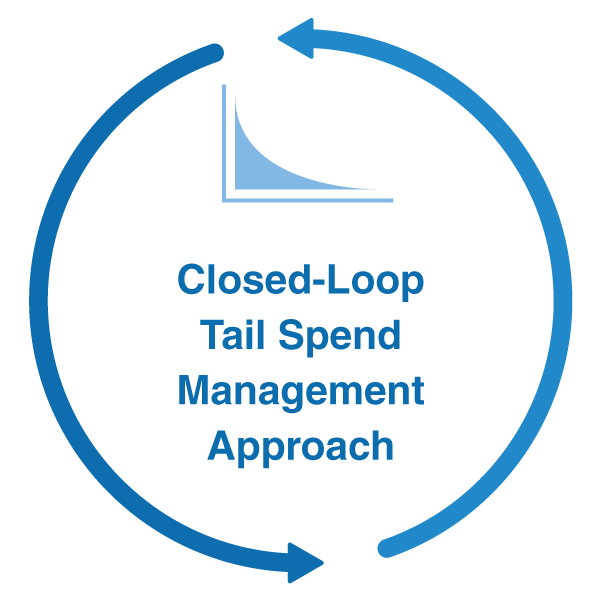
Reactive Approach: Ongoing management of all requisitions received through project-based sourcing to drive compliance and generate value.
Proactive Approach: A parallel work stream to analyze spend trends and opportunities and drive improved value through redirection via preferred channels, three-bid-and-buy, RFQ, mini-RFP, accelerated sourcing, auctions, etc.
AUTOMATION OPPORTUNITIES USING CLOSED-LOOP TAIL SPEND MANAGEMENT: INDIRECT SPEND
A leading global life sciences organization successfully adopted various approaches, fully integrated with a cloud-based S2P platform, in its digital procurement transformation journey. A series of initiatives helped reduce the bottlenecks in procurement. The organization reported happier partners with a simplified and well-documented process that was implemented across all levels of the corporation.
As the transformation program evolved, the organization periodically reviewed its spend thresholds. In many instances, automation provided an opportunity to increase the existing thresholds and bring more spend under management, which in turn translated into higher productivity.
AUTOMATION OPPORTUNITY 1: CATALOG IMPLEMENTATION
Categories such as laboratory and office supplies that generate a substantial number of transactions are ideal for catalog implementation. A thorough sourcing process can help an organization identify its preferred suppliers for providing the required goods and services. Once the preferred suppliers are defined and specifications are established, information is uploaded and displayed in a visual catalog.
There are two types of catalogs that can be implemented: hosted and punchouts. The process is similar to making a purchase on Amazon. Requesters go through the catalog, add the item to their shopping carts, and check out when ready. The payment process could be administered on a third-party tool.

AUTOMATION OPPORTUNITY 2: SPOT BUY AUTOMATION
The organization decided to digitize transactions by setting up a spot buy office, where every transaction below a certain spend threshold could be processed faster. This technology can classify new purchase orders, group them into the right buckets, and route them to a limited group of people for quick review.

AUTOMATION OPPORTUNITY 3: PURCHASE ORDER UNDER CONTRACT
The organization implemented a different process for trusted suppliers that already had a valid master service agreement (MSA)/contract in place. A new PO can be approved without having to create a detailed SOW or one-time agreement. Instead, new service requests can be captured in the addenda of the existing contract. The number of work orders and change orders is reduced because the details in the PO are sufficient. The contracting team’s capacity is conserved and cycle times improve because pre-populated templates are used.

AUTOMATION OPPORTUNITY 4: CONTRACTING WITH PREAPPROVED TEMPLATES
The organization standardized the contracting process for suppliers that always required a contract. Preapproved templates help streamline and automate the authoring, filling, and reviewing of different contract types or high-volume repetitive contracts. Spend thresholds need to be refreshed periodically to optimize the number of contracts. For example, over time the threshold might be increased to more than $100,000 as tail spend decreases.

AUTOMATION OPPORTUNITY 5: AUTO-BID
The procurement team had been relying on manual processes to handle approximately 2,000 purchase requisitions and $35-40 million in spend annually. Senior leaders expressed dissatisfaction with requisitioning pipeline management, along with the long turnaround time for these requests. They asked for more integration between sourcing and purchasing (e.g., flipping an RFx to PO) and streamlining event communications for all participants.
Now, the S2P platform provides for fully automated bidding across multiple rounds of negotiations handled on a single channel.

The primary benefits of each of these five automation approaches are summarized below.
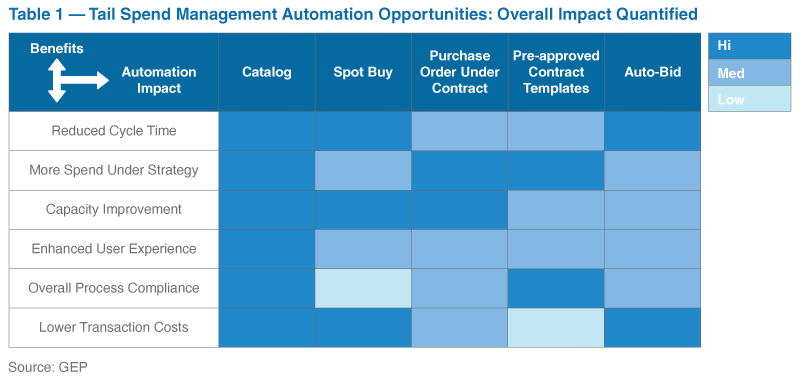
For the organization, each initiative has had varying degrees of impact based on the effort required. In the chart below, impact is measured in terms of process efficiency and effectiveness, and user experience. Ease of implementation is measured in terms of FTE hours spent on execution.
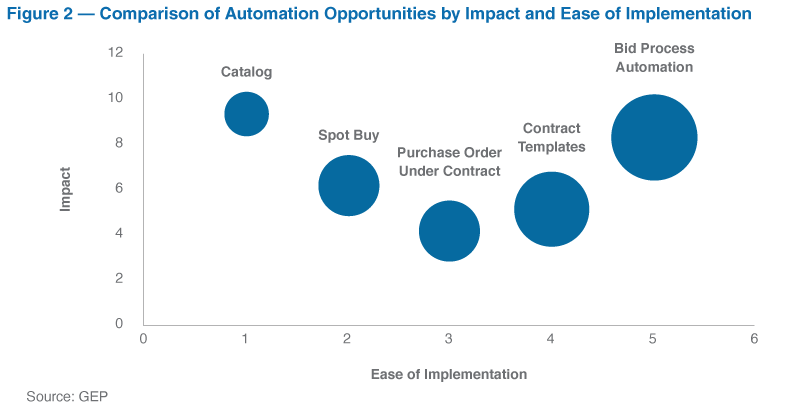
TIERING: A PRACTICAL SUPPLIER REDUCTION TACTIC
Advanced S2P platforms use tiering to proactively address long supplier tail spend and rationalize the supply base. In a typical scenario, an S2P platform enhances control of supplier data by informing the user of the close resemblance between a new supplier and an existing supplier. The user is prompted to establish a relationship between the new and existing suppliers, which promotes better data structuring and allows more accurate spend tracking and supply management.

The technology will be more effective if the process is accompanied by an active effort to reduce the number of low-dollar transaction suppliers. The multi-billion-dollar life sciences organization referenced earlier proactively directed spend to preferred suppliers and consolidated tail suppliers with managed service provider (MSP) suppliers. Key steps in this process included:
1. Reviewing the business backgrounds of potential suppliers against acceptable thresholds, as well as the products or services purchased
2. Evaluating the geographical distribution of the products
3. Mapping the businesses and services against strategic suppliers
As a result, the organization reduced new supplier additions by 10%-15% and tail spend per category by 8%-10%, and realized 10%-15% savings with its successful TSM program.

OPPORTUNITIES IN DIRECT SPEND MANAGEMENT
Enterprise leaders are increasingly aware that new procurement technologies can be the catalyst for effective management of direct spend. Spend analytics built on AI and machine learning capabilities offer a globally integrated view of the supply chain network, allowing leading organizations to get a handle on the complexity that was magnified by the global pandemic. The key is to increase visibility into multiple systems.
Raw materials demanded in lower quantities or parts purchased from local suppliers unmistakably contribute to tail spend. The essential pieces of information required for analysis are: 1) price paid, and 2) material invoice line descriptions. AI can detect differences in product specifications and allow the buying organization to assess the urgency of the need for related or duplicate material parts.
The most-needed parts can then be consolidated with one or two aggregators in the industry to benefit from economies of scale or scope. Aggregators will have the ability to negotiate down prices set by original equipment manufacturers (OEMs), since they serve multiple clients who each request small quantities of the same product. Especially in manufacturing, increased buying power leads to lower prices, better agreement terms and just-in-time delivery.
AI will also be instrumental in promoting price competition among multiple aggregators. If internal and external benchmarks are available, advanced analytics can clarify how much an item “should cost.” Integrating external data feeds or market indices will allow for dynamic pricing based on inflated or deflated raw material costs. Buyers tracking market prices will gain advantage from this intelligence in complex cost-based pricing negotiations or forward-looking demand predictions.

ADOPTION AND CHANGE MANAGEMENT
There are two main technology-driven TSM adoption models. Procurement and operations leaders, who understand the dynamics of their organization and their industry, can intelligently choose the most suitable implementation option based on future-state vision, available timeline and budget. (A hybrid of the two models is also possible, and the life sciences organization featured in this paper used this approach to achieve its TSM results.)
Policy-Driven Model
Corporate policy mandates that all requests should go through a stated procurement process to increase managed spend. The sourcing team is the sole manager of all defined spend types. Notably, this approach is easier to implement; but it requires a significant change management effort from the leadership.
S2P platform providers should support organizational purchasing policies and processes by directing business partners to the appropriate channels based on the configurations of the software. The architecture of the tool should also encourage compliance by addressing pain points like information retrieval with advanced search and information-processing capabilities.
On-Demand Service Model
A buying team service is “sold” to the rest of the organization; business users can use a third-party buying desk to source equipment, material, and services that contribute to tail spend. This model creates less resistance and increased savings from the reactive and proactive approaches of the closed-loop TSM process.
IN CONCLUSION
Successful implementation of automation technology with the help of the strategies outlined in this paper can help digitize 70%-75% of tail spend, far higher than the industry average.1 The use of AI, machine learning and other “intelligent” technologies can enhance control and minimize human intervention to manage tail spend effectively and help enterprises be more resilient in the face of economic volatility, global health crises and increased competition.
1 GEP Analysis

